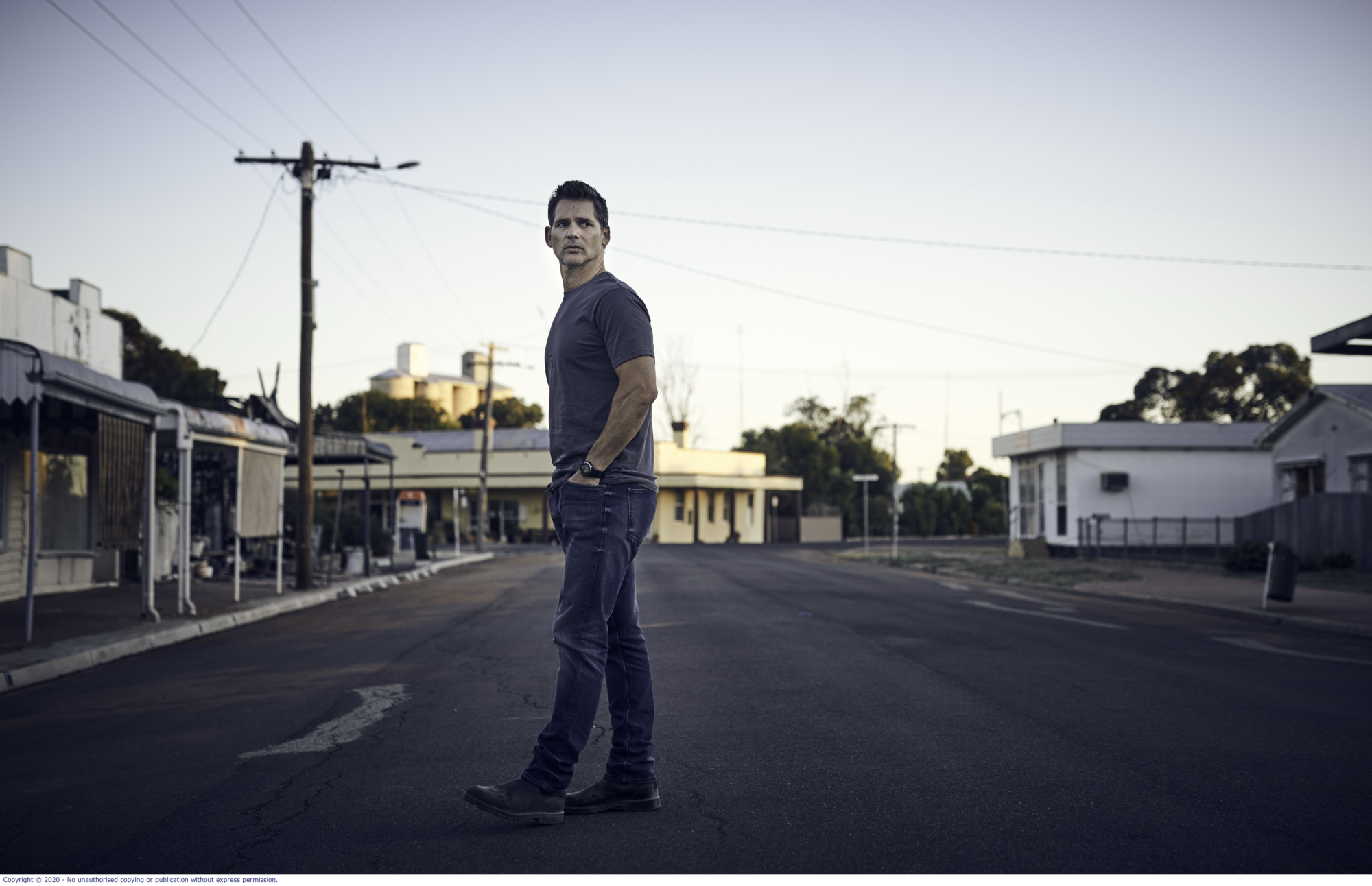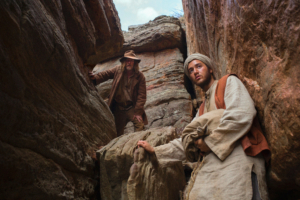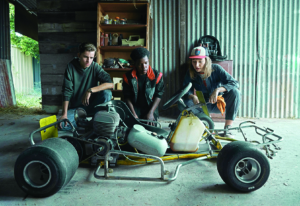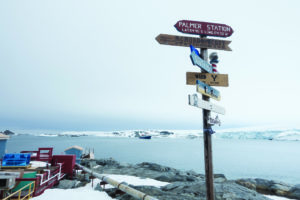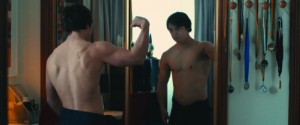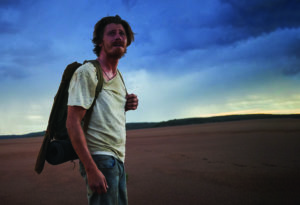Jane Harper’s debut novel The Dry was optioned for the screen before it was even published.[1]Hannah Francis, ‘Jane Harper’s The Dry, Already Optioned by Reese Witherspoon, Debuts in the US to Glowing Praise’, The Sydney Morning Herald, 10 January 2017, <https://www.smh.com.au/entertainment/books/jane-harpers-dry-already-optioned-by-reese-witherspoon-debuts-in-the-us-to-glowing-praise-20170110-gtoz3l.html>, accessed 18 January 2021. Set in the fictional drought-stricken rural community of Kiewarra, where the sun beats down relentlessly on buried secrets, the novel tells a gripping mystery story that foregrounds mood and setting in a way that reads like a screen treatment.
But would it be a big- or small-screen story? The obvious choice would have been television, where many adaptations of crime novels have found a home. As journalist Linda Morris observed in 2018, ‘New streaming services have ratcheted up demand for compelling long-form content – and crime fiction, with its complex and suspenseful plotlines, offers hugely saleable products with a ready-made audience.’[2]Linda Morris, ‘The New Thirst for Australian Crime Reads’, The Sydney Morning Herald, 31 August 2018, <https://www.smh.com.au/entertainment/books/the-new-thirst-for-australian-crime
-reads-20180821-p4zyt0.html>, accessed 17 January 2021.
Ultimately, The Dry became a 2021 feature film directed by Robert Connolly. Producer Jodi Matterson told Screen Australia:
It’s really the filmmakers and the material that drives us more than saying, ‘oh, we’ve got a slot, we need to be making two TV shows now and we need to make one film now’. It’s much more emotional than that. We find a book that we all fall in love with and then we go into developing that and things happen on their own timeline.[3]Jodi Matterson, quoted in Caris Bizzaca, ‘Made Up Stories: The Dry, Penguin Bloom & More’, Screen Australia website, 14 January 2021, <https://www.screenaustralia.gov.au/sa/screen-news/2021/01-14-made-up-stories-the-dry-penguin-bloom>, accessed 17 January 2021.
What struck me most about The Dry, having enjoyed its source novel, was how faithfully the screenplay by Connolly and Harry Cripps renders the plot, including its digressive flashback sequences. In his first on-screen Australian film role since Romulus, My Father (Richard Roxburgh, 2007), Eric Bana stars as Australian Federal Police investigator Aaron Falk, who returns reluctantly to his home town, Kiewarra, for the funeral of his childhood best friend, Luke (Martin Dingle Wall). Everyone in town assumes Luke, a drought-stressed farmer, murdered his wife and son before turning the gun on himself; but Luke’s grimly grieving dad, Gerry (Bruce Spence), believes otherwise. He wants Aaron to look into the case – and he’s calling in an old debt.
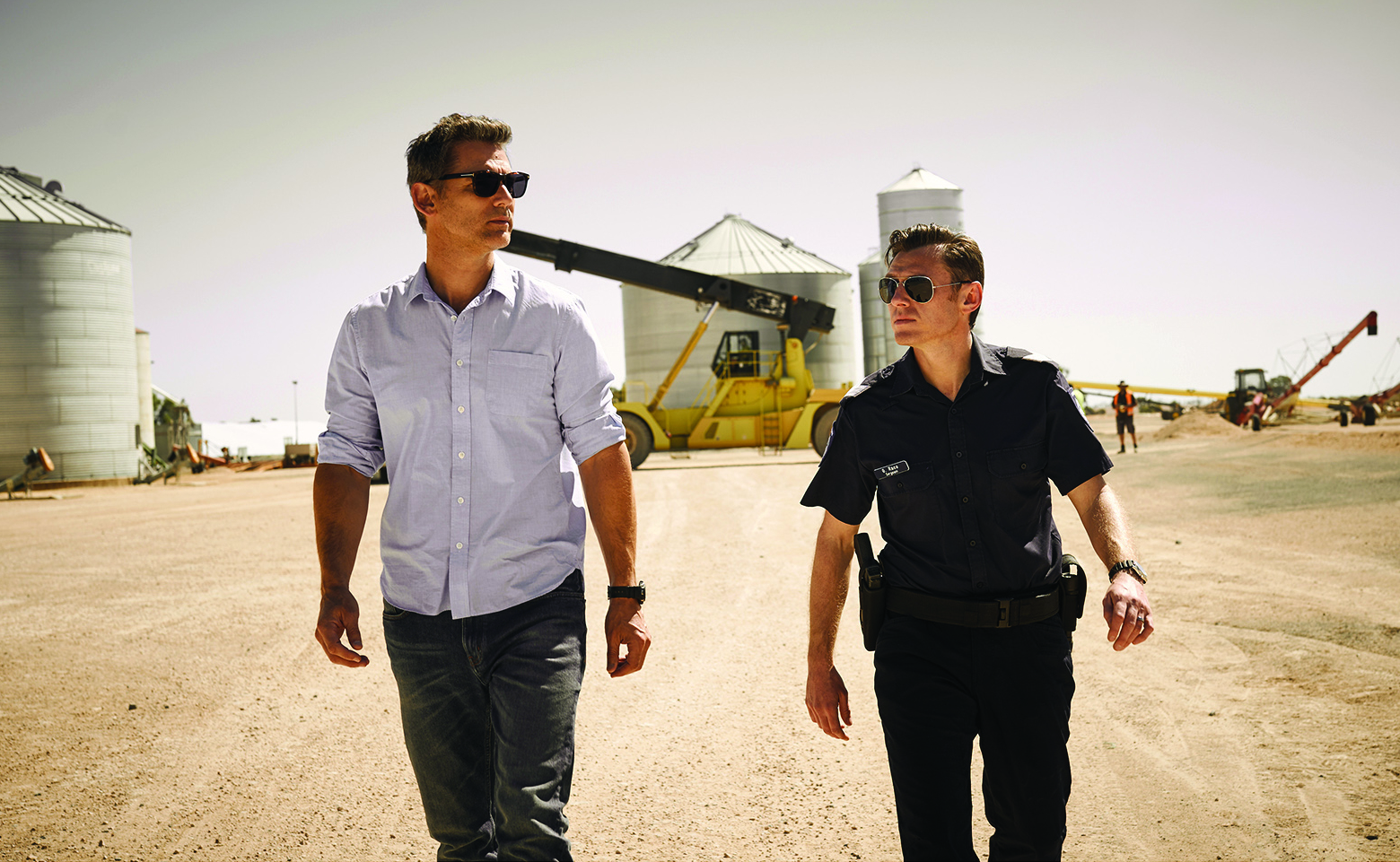
Gerry knows Aaron and Luke lied about their whereabouts on the night their close friend Ellie (BeBe Bettencourt) drowned mysteriously in the river (in the book, this happened twenty years ago; but having cast the gen X Bana, this film pushes Ellie’s death back to 1991). Indeed, many in Kiewarra suspect Aaron killed Ellie – chiefly, Ellie’s dad, Mal (William Zappa), and her cousin Grant (Matt Nable), who, as we see in flashback, ran the teenage Aaron (Joe Klocek) and his dad (Jeremy Lindsay Taylor) out of town.
Aaron reluctantly extends his stay at the local pub, liaising with the earnest, new-in-town sergeant Greg (Keir O’Donnell). Together, they review security footage and interview locals, including the belligerent Grant; school principal Scott (John Polson) and his nervous wife, Sandra (Renee Lim); and a surly young farmer, Jamie (James Frecheville), who was the last person to see Luke alive.
Aaron’s teenage memories keep welling up, saturating him like Kiewarra’s missing water – or like the invasive rabbits that Luke and Jamie were allegedly shooting, and that Luke’s former girlfriend Gretchen (Genevieve O’Reilly) is also a suspiciously dab hand at putting down. These are my own metaphors, though. While the film is well crafted, it’s unfancy in a way that feels more televisual than cinematic: driven by pure story, with little interest in exploring characters, emotions or social contexts.

Balancing plot, character and commentary
Reviewing Jasper Jones (Rachel Perkins, 2017) – another Australian mystery novel adapted to the big screen – Ellen van Neerven observes that ‘the “crime mystery” element is somewhat fuzzy but, arguably, we don’t watch the film for that. The social commentary is more interesting.’[4]Ellen van Neerven, ‘Through the Window: The Trap of Curiosity in Rachel Perkins’ Jasper Jones’, Metro, no. 193, 2017, p. 10. She then argues that Perkins’ film fails to satisfy on these grounds, too.
Jasper Jones’ title character (Aaron McGrath), an Aboriginal teenager afraid he’ll be accused of murdering his white girlfriend Laura (Nandalie Campbell Killick), is not the protagonist; this, rather, is a younger white boy, Charlie (Levi Miller), whose ‘curiosity’ impels him to solve the mystery with the help of Laura’s younger sister Eliza (Angourie Rice). For van Neerven, the decision to frame Laura’s death from Charlie’s perspective, as a coming-of-age ‘loss of innocence’ story, misses an opportunity for a broader social critique.
Like Charlie’s in Jasper Jones, Aaron’s procedural investigation in The Dry is really an exercise in his own personal growth: Connolly’s perfunctory storytelling suggests that Aaron’s trauma stems straightforwardly from the violent death of his first love and the unfairness of being uprooted from home. The film effectively overlaps Aaron’s flashback sequences with his present-day pilgrimages to the now-desiccated sacred sites of his youth. As he remembers the milky-brown river water and gentle grey-green foliage, Ellie’s river-damp skin and her campfire-lit face, the drought feels like a genuine metaphor for his loss as he walks through those same trees, now dead and colourless, and along the canyon the river has become.
While the film is well crafted, it’s unfancy in a way that feels more televisual than cinematic: driven by pure story, with little interest in exploring characters, emotions or social contexts.
But these are brief interludes of audiovisual poetry in a film that otherwise retreats to the safety of plot, refusing to explore the social resonances of Aaron’s intertwined grief for his lost friends and dried-up home country. The Dry was filmed on unceded Wotjobaluk, Jaadwa, Jadawadjali, Wergaia and Jupagulk lands, where many people of these nations were massacred.[5]See ‘Massacre Map’, Culture Victoria website, <https://cv.vic.gov.au/stories/aboriginal-culture/indigenous-stories-about-war-and-invasion/massacre-map/>, accessed 18 February 2021. Yet the Aboriginality of Greg’s pregnant wife, Rita (Miranda Tapsell), goes unremarked upon in a story that’s exclusively about white people’s suffering and relationship to place.
Stefan Duscio’s bland cinematography makes Kiewarra’s economic desperation and buried secrets feel like a photocopy of Wake in Fright (Ted Kotcheff, 1971). And his repeated use of overhead tracking shots across dusty paddocks invites unflattering comparisons to the more elegant use of the same visual device in the thematically sophisticated Mystery Road (Ivan Sen, 2013), which, like Jindabyne (Ray Lawrence, 2006), uses its storytelling to plumb fraught intersections of race, gender, landscape and justice.
While Aaron experiences his exile from Kiewarra as a kind of banishment from Eden, Gretchen’s arguably more depressing fate is to be stranded there, suffocating in drought and loneliness rather than dwelling in burnished memory like the dead Ellie. Gretchen reminded me of Sally (Rachel Griffiths) in Beautiful Kate (Rachel Ward, 2009), a gothic melodrama adapted from a novel by US author Newton Thornburg. Its jaded protagonist, Ned (Ben Mendelsohn), returns to his family’s remote farm where his sister Sally is, thanklessly, caring for their dying father Bruce (Bryan Brown). Like Aaron in The Dry, Ned is haunted by teenage trauma – here, a forbidden desire for his femme fatale twin sister Kate (Sophie Lowe), who died violently years earlier along with their elder brother Cliff (Josh McFarlane).
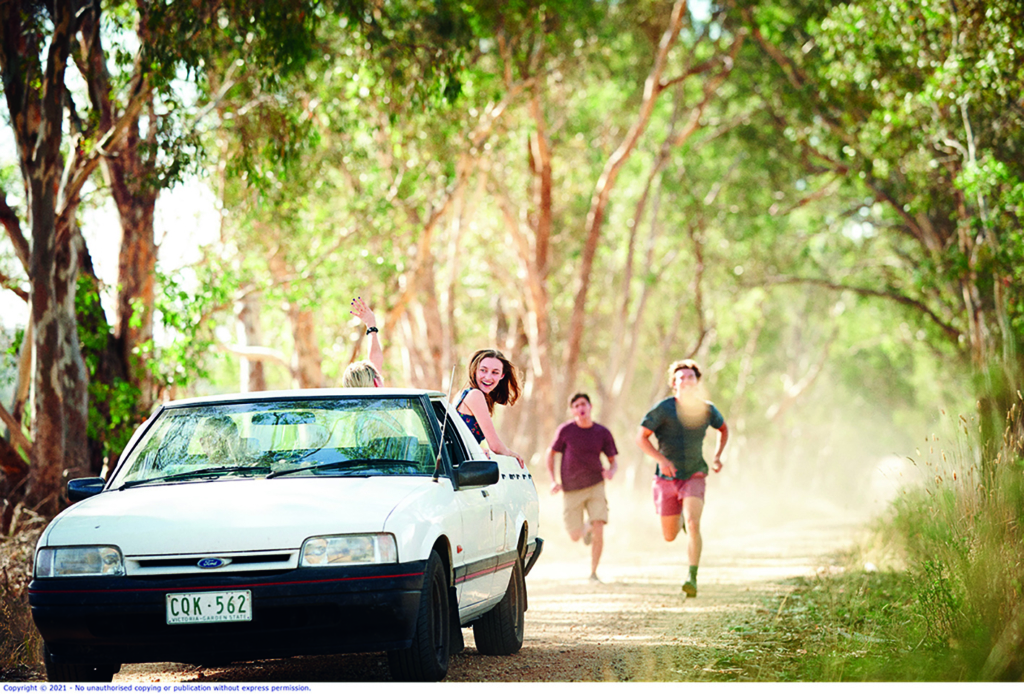
From as far back as Jedda (Charles Chauvel, 1955) and Picnic at Hanging Rock (Peter Weir, 1975), Australian cinema has shown an eroticised fascination with doomed girls; and Beautiful Kate subverts the way men project their neuroses onto the women around them. Kate is a sometimes unlikeable and completely ungovernable figure; but Ellie in The Dry seems to exist purely to tempt both teenage Aaron and Luke (Sam Corlett). She’s a plot point, not a character.
In the film’s final moments, Aaron learns that Ellie had been abused by her father, then murdered by him when she tried to escape Kiewarra. In the novel, this bittersweet coda is cathartic, because Harper has built so much tension around the possibility that Luke killed Ellie – or even that Aaron did, meaning that he would have deserved the townsfolk’s ostracism. However, there’s no such tension here: the likeable Bana plays Aaron in a world-weary but earnest way that never conjures a sense of danger or moral ambiguity. The unrepentant murderer Bana played in Chopper (Andrew Dominik, 2000) is long gone.
Cinematic … or televisual?
Thanks in part to the chilling effect of the COVID-19 pandemic on Hollywood, The Dry’s big-screen gamble paid off. The film hit cinemas on 1 January 2021, and with few US and UK competitors in what would previously have been a bumper release period for international studio films, it had made A$6.92 million at the Australian box office in its first two weeks of release, and more than 450,000 people had paid to see it.[6]David Tiley, ‘Box Office: The Dry Is a Great Start to the Year for Australian Screen Sector’, ArtsHub, 12 January 2021, <https://www.artshub.com.au/news-article/news/film/david-tiley/box-office-the-dry-is-a-great-start-to-the-year-for-australian-screen-sector-261715>, accessed 17 January 2021. By 16 March, it had earned A$19.82 million, and was on track to enter the top ten highest-grossing Australian films of all time.[7]David Tiley, ‘Box Office: Dry Lunges Towards $20 Million as Docs Stay on the Edges’, ArtsHub, 16 March 2021,<https://www.artshub.com.au/news-article/news/film/david-tiley/box-office-dry-lunges-towards-20-million-as-docs-stay-on-the-edges-262113>, accessed 19 March 2021.

Such box-office success, however, says more about 2020–2021’s unusual market conditions than about Australian audiences’ appetite for big-screen mystery. ArtsHub’s David Tiley noted that ‘the box office record for tense gritty Australian thrillers in the domestic market is terrible’. Wolf Creek 2 (Greg McLean, 2013) earned A$4.73 million, Mystery Road earned A$281,000 and the latter’s sequel, Goldstone (Sen, 2016), A$915,000. The multi-award-winning The Babadook (Jennifer Kent, 2014) took only A$236,000 in Australian cinemas, although Kent’s 2018 follow-up, The Nightingale, did better with A$544,000.[8]Tiley, op. cit.
Critic Lauren Carroll Harris has argued that, as streaming services complicate the distribution channels that once distinguished cinema from television, we can make similar distinctions on formal grounds. ‘Throughout its short history, television has rarely trafficked in visual metaphor and abstraction,’ she writes; instead, it’s been moulded by its repertoire of formats – particularly soap operas and sitcoms, which ‘tend to be plot-oriented, following the everyday dramas of romances, breakups, career scandal and family intrigue’.[9]Lauren Carroll Harris, ‘Beyond Plot, Beyond Story’, Kill Your Darlings, 14 February 2018, <https://www.killyourdarlings.com.au/article/beyond-plot-beyond-story-cinematic-television-today/>, accessed 17 February 2021.
To these plot-driven formats, I would add the crime-procedural genre within which The Dry operates. As a detective story, it picks up and dismisses suspects and clues in a perfunctory way, without much genuine suspense – because the gears of plot require it. Like the revelation of how Ellie died, the final identification of Luke’s killer seems rushed, and doesn’t pack the punch it does in the novel.
If ‘televisuality’ is about plot, then Carroll Harris suggests that a text can be considered ‘cinematic’ when it answers this question: ‘How can storytelling represent an emotional state through audiovisual subtlety and subtext rather than the literalness of dialogue?’[10]ibid. Perhaps Connolly did not fully harness the expressive, thematic, self-reflexive capacities of audiovisual storytelling because The Dry is intended to be televisual, not cinematic – a more explicitly commercial, populist big-screen counterpart to the intellectualised ‘cinematic television’ that characterises the post-broadcast era.
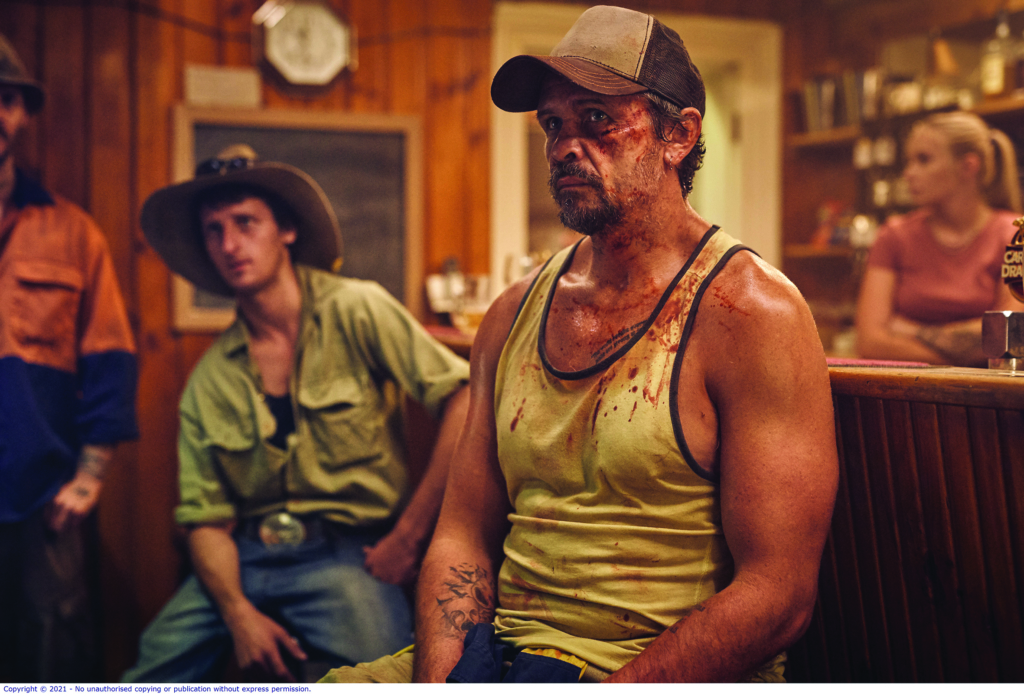
However, a series format might have suited this storytelling approach better: with more screen time, Connolly might have had space to build the tension that’s missing from The Dry, and the characters might not have seemed quite so thinly drawn. However, in a franchise-driven entertainment era, perhaps The Dry was intended as a curtain-raiser for a future Aaron Falk screen universe.
There’s plenty of precedent for this in the Australian film and television markets. For example, the Jack Irish franchise, adapted from Peter Temple’s crime novels, began as three feature-length telemovies directed by Jeffrey Walker and starring Guy Pearce in the title role: Jack Irish: Bad Debts (2012), Jack Irish: Black Tide (2012) and Jack Irish: Dead Point (2014). In 2016, these were spun off, along with their key cast, into a one-hour-timeslot television series, Jack Irish, whose third season is set to screen on ABC TV in 2021.
The telemovies hewed closely to the hard-boiled film noir genre: Jack begins as a high-flying criminal lawyer, but after a disgruntled client murders his wife, he hits the bottle and becomes a shaggy underworld denizen and part-time private investigator. But the later series is more televisual, edging closer to sitcom territory; as critic Luke Buckmaster observes in The Guardian, ‘There’s more humour than in previous instalments, mostly involving Jack’s indignation towards something or other.’[11]Luke Buckmaster, ‘Jack Irish Review – Guy Pearce Turns up the Noirish Charm in New TV Series’, The Guardian, 11 February 2016, <https://www.theguardian.com/tv-and-radio/2016/feb/11/jack-irish-review-guy-pearce-turns-up-the-noirish-charm-in-new-tv-series>, accessed 16 February 2021.
Conversely, Sen has sustained Mystery Road’s cinematic qualities on both big and small screens by asking the kinds of political questions The Dry eschews: What does it take to feel at home in a place, or feel dispossessed and alienated? Why do those with power strive to own and exploit both human and natural resources? The original film follows Indigenous police detective Jay (Aaron Pedersen) as he returns to his rural Queensland home town: while investigating a murder, he uncovers a drug- and sex-trafficking racket involving his own colleagues. Goldstone takes up Jay’s story three years on, as he fights his own demons as well as a corrupt mining-town mayor and mine boss with the help of an idealistic young cop (Alex Russell).
A series format might have suited this storytelling approach better: with more screen time, Connolly might have had space to build the tension that’s missing from The Dry.
Mystery Road then became an ABC television series, set in the gap between the two films. Both 2018’s first six-episode season (helmed by Perkins) and the second in 2020 (directed by Warwick Thornton and Wayne Blair) continue the films’ nuanced exploration of the tensions and misapprehensions between white and Aboriginal people, along with the baked-in racism, exploitation and corruption Jay encounters – in which, as ever, Jay’s ex-wife, Mary (Tasma Walton), and daughter, Crystal (Madeleine Madden), become entangled.
As Sunday Age critic Craig Mathieson wrote, Mystery Road the film ‘bridges the current divide in Australian cinema with a prominent and precise work: it is a genre [piece] that unfolds along almost classical lines’.[12]Craig Mathieson, ‘Mystery Road’, The Sunday Age, 13 October 2013, archived at <https://web.archive.org/web/20131015192434/https://www.theage.com.au/entertainment/movies/mystery-road-20131010-2vami.html>, accessed 18 February 2021. Sen’s assured command of mood through striking visuals makes it cinematic, while his intuitive grasp of western (or neo-noir[13]Critics have categorised Mystery Road as both western and film noir (or ‘outback noir’). For example, Mike Hale writes, ‘Mystery Road is frequently labeled outback noir, but with its vistas, its sweaty, buggy ambience and its frontier righteousness, it’s really a hard-boiled neo-western.’ See Hale, ‘Review: A Classic Western Sheriff on the Other Side of the World’, The New York Times, 11 October 2020, <https://www.nytimes.com/2020/10/11/arts/television/review-mystery-road.html>. Meanwhile, Luke Buckmaster argues that Sen’s work is a hybrid of both genres; see Buckmaster, ‘Goldstone Review – a Masterpiece of Outback Noir that Packs a Political Punch’, The Guardian, 9 June 2016, <https://www.theguardian.com/film/2016/jun/09/goldstone-review-a-masterpiece-of-outback-noir-that-packs-a-political-punch>, both accessed 17 February 2021.) plotting make it entertaining in a televisual sense. Thus, Guardian journalist Jim Poe suggested the film was ‘aimed at – and deserving of – an audience beyond the arthouse’.[14]Jim Poe, ‘Ivan Sen on Mystery Road: “Reality Is Much Darker than This Film”’, The Guardian, 18 October 2013, <https://www.theguardian.com/culture/2013/oct/18/mystery-road-film-western-australia>, accessed 16 February 2021.
A faithful adaptation of a phenomenally popular novel, The Dry has also been extraordinarily successful in commercial terms. Indeed, at least part of its success comes from the procedural familiarity of crime storytelling, which is the format’s chief pleasure. But The Dry’s big-screen context offered an opportunity to reframe its source material in the expressive, allusive ways only cinema can, and Connolly rejected that opportunity. As I watched, I found myself wishing for more – just as Aaron screams in frustration when he turns on the shower, but the tap yields only a muddy trickle.
Endnotes
| 1 | Hannah Francis, ‘Jane Harper’s The Dry, Already Optioned by Reese Witherspoon, Debuts in the US to Glowing Praise’, The Sydney Morning Herald, 10 January 2017, <https://www.smh.com.au/entertainment/books/jane-harpers-dry-already-optioned-by-reese-witherspoon-debuts-in-the-us-to-glowing-praise-20170110-gtoz3l.html>, accessed 18 January 2021. |
|---|---|
| 2 | Linda Morris, ‘The New Thirst for Australian Crime Reads’, The Sydney Morning Herald, 31 August 2018, <https://www.smh.com.au/entertainment/books/the-new-thirst-for-australian-crime -reads-20180821-p4zyt0.html>, accessed 17 January 2021. |
| 3 | Jodi Matterson, quoted in Caris Bizzaca, ‘Made Up Stories: The Dry, Penguin Bloom & More’, Screen Australia website, 14 January 2021, <https://www.screenaustralia.gov.au/sa/screen-news/2021/01-14-made-up-stories-the-dry-penguin-bloom>, accessed 17 January 2021. |
| 4 | Ellen van Neerven, ‘Through the Window: The Trap of Curiosity in Rachel Perkins’ Jasper Jones’, Metro, no. 193, 2017, p. 10. |
| 5 | See ‘Massacre Map’, Culture Victoria website, <https://cv.vic.gov.au/stories/aboriginal-culture/indigenous-stories-about-war-and-invasion/massacre-map/>, accessed 18 February 2021. |
| 6 | David Tiley, ‘Box Office: The Dry Is a Great Start to the Year for Australian Screen Sector’, ArtsHub, 12 January 2021, <https://www.artshub.com.au/news-article/news/film/david-tiley/box-office-the-dry-is-a-great-start-to-the-year-for-australian-screen-sector-261715>, accessed 17 January 2021. |
| 7 | David Tiley, ‘Box Office: Dry Lunges Towards $20 Million as Docs Stay on the Edges’, ArtsHub, 16 March 2021,<https://www.artshub.com.au/news-article/news/film/david-tiley/box-office-dry-lunges-towards-20-million-as-docs-stay-on-the-edges-262113>, accessed 19 March 2021. |
| 8 | Tiley, op. cit. |
| 9 | Lauren Carroll Harris, ‘Beyond Plot, Beyond Story’, Kill Your Darlings, 14 February 2018, <https://www.killyourdarlings.com.au/article/beyond-plot-beyond-story-cinematic-television-today/>, accessed 17 February 2021. |
| 10 | ibid. |
| 11 | Luke Buckmaster, ‘Jack Irish Review – Guy Pearce Turns up the Noirish Charm in New TV Series’, The Guardian, 11 February 2016, <https://www.theguardian.com/tv-and-radio/2016/feb/11/jack-irish-review-guy-pearce-turns-up-the-noirish-charm-in-new-tv-series>, accessed 16 February 2021. |
| 12 | Craig Mathieson, ‘Mystery Road’, The Sunday Age, 13 October 2013, archived at <https://web.archive.org/web/20131015192434/https://www.theage.com.au/entertainment/movies/mystery-road-20131010-2vami.html>, accessed 18 February 2021. |
| 13 | Critics have categorised Mystery Road as both western and film noir (or ‘outback noir’). For example, Mike Hale writes, ‘Mystery Road is frequently labeled outback noir, but with its vistas, its sweaty, buggy ambience and its frontier righteousness, it’s really a hard-boiled neo-western.’ See Hale, ‘Review: A Classic Western Sheriff on the Other Side of the World’, The New York Times, 11 October 2020, <https://www.nytimes.com/2020/10/11/arts/television/review-mystery-road.html>. Meanwhile, Luke Buckmaster argues that Sen’s work is a hybrid of both genres; see Buckmaster, ‘Goldstone Review – a Masterpiece of Outback Noir that Packs a Political Punch’, The Guardian, 9 June 2016, <https://www.theguardian.com/film/2016/jun/09/goldstone-review-a-masterpiece-of-outback-noir-that-packs-a-political-punch>, both accessed 17 February 2021. |
| 14 | Jim Poe, ‘Ivan Sen on Mystery Road: “Reality Is Much Darker than This Film”’, The Guardian, 18 October 2013, <https://www.theguardian.com/culture/2013/oct/18/mystery-road-film-western-australia>, accessed 16 February 2021. |
